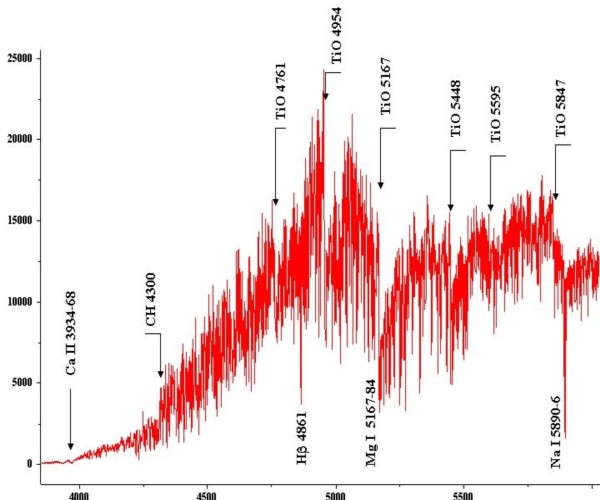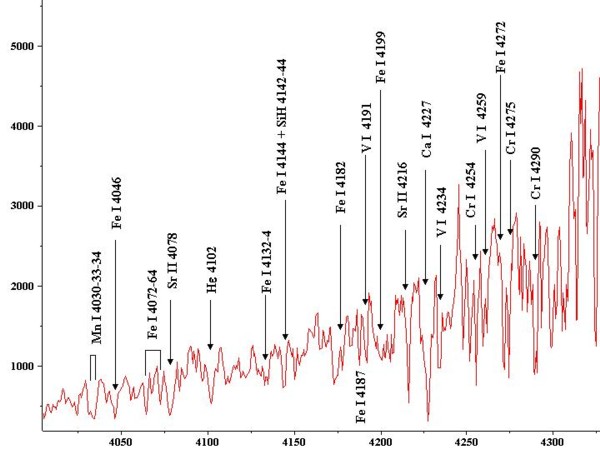NORMAL STARS SPECTRA
Spectral Classes:
O
- B
- A
- F
- G
- K
- M
Type M stars
Type M stars are at the cold end of the spectral sequence, with temperatures that ranges
from 3900 K at M0 to 2600 K for M8 V.
Among a subclass, supergiants have a temperature some 300 K lower than dwarfs.
Type M giants and dwarfs have a very different hystory.
Dwarfs are the smallest stars on the main sequence, with a mass as low as 8% of solar
mass. They burns slowly their hydrogen and their lives last for billions years.
Their absolute magnitude is very low, some 10000 times fainter than our sun.
On the contrary, giants and supergiants are stars that once belonged to the main sequence
of classes B-A-F-G-K, and now are evolving toward a planetary nebula or a supernova.
During this process, they become bigger and bigger and thus very bright (some 600'000 times
our sun, in the case of m Cephei).
The size of such supergiants can be often compared with Jupiter or Saturn orbits.
As an example, m Cephei has a diameter
that approaches 11 AU.
Even if the M dwarfs are in great number, due to their low absolute magnitude (
MV>8) none can be seen to the naked eye.
Among the more representative Dwarfs we find:
Barnard star(in Ofiucus M5 V), Kruger 60 A e B (in Cepheus M3 V e M4 V), 40 Eri C,
Proxima Cen (dM5e, flare star).
Among the giants:
b And (M0 III),
b Peg (M2 II-III),
h Gem (M3 III),
r Per (M4 II),
W Cyg (M5 III), Mira Ceti (M7 IIIe).
Among the supergiants:
Antares (M1 Ib), m Cephei (M2 Ia),
Betelgeuse (M2 Iab), SU Persei (M4 Iab)

|
Picture 1: Spectrum of Betelgeuse ( a Ori - M2 Iab)
from 3800 to 6000 ┼ recorded with a resolution of 1 ┼.
The TiO molecular bands are marked. The comparison with the spectrum of Mira (picture 3)
shows that TiO bands strenghtens tower colder subtypes.
|
From the spectroscopic point of view, M type stars show a banded spectrum, interrupted
by molecular bands. Observed molecules are TiO, VO and in colder subtypes also MgH
2 e H2.
Spectrum is also filled with sharp lines that comes from neutral metals such Fe, V, Mg, Mn.
The classification of luminosity classes can be done observing the Balmer lines that
can be seen in giants (see picture 2) but not in dwarfs.
A negative effect is observed for 4227 ┼ line of neutral Calcium tht does not change with
temperature but weaken as the density drop.

|
Picture 2: Detailed view of a part of Betelgeuse ( a
Ori - M2 Iab) spectrum from 4000 to 4350 ┼ recorded with 1 ┼ resolution.
Various metallic lines are identified. Are also visible the Hd
and He Balmer lines.
|

|
Picture 3: Spectrum of Mira Ceti ( o
Ceti - M7 IIIe) from 4000 to 6800 ┼ recorded close to maximum of light with 30
sec exposure on TP2415 film with 100 ┼/mm dispersion.
Mira is an easy object for amateur spectroscopist because even at low dispersion,
the broad molecular absorbtion can be seen very well.
Hydrogen emission lines are due to the gas envelope around the star.
|
Goto other spectral classes:
O
- B
- A
- F
- G
- K
|
|



